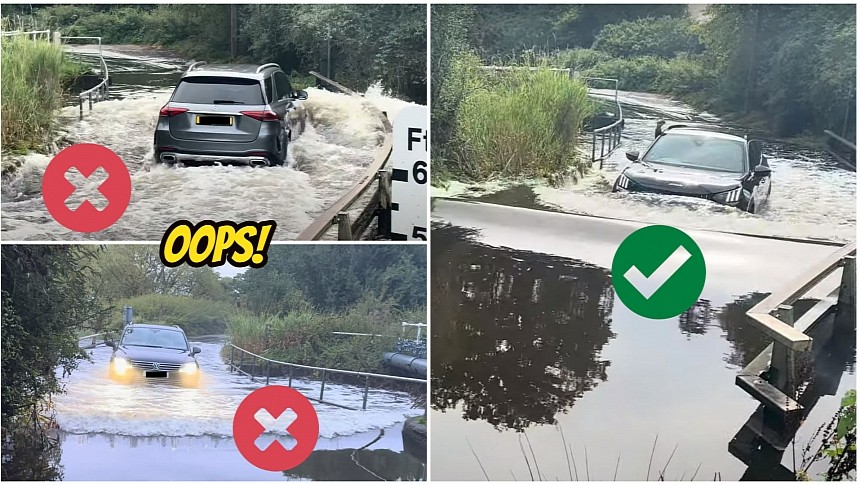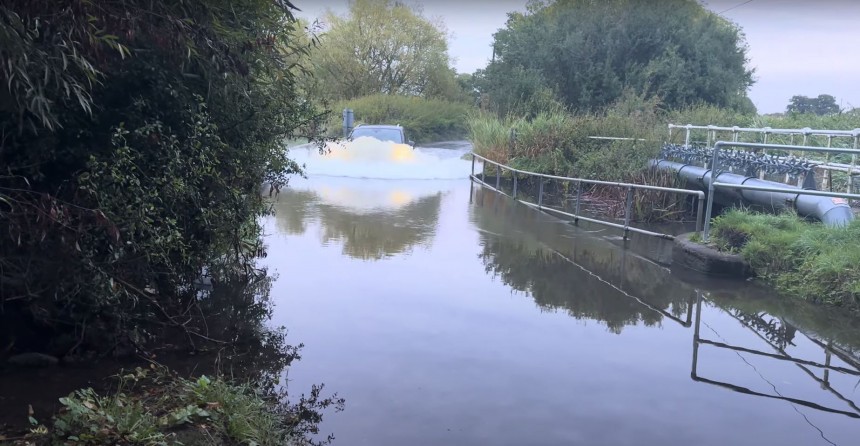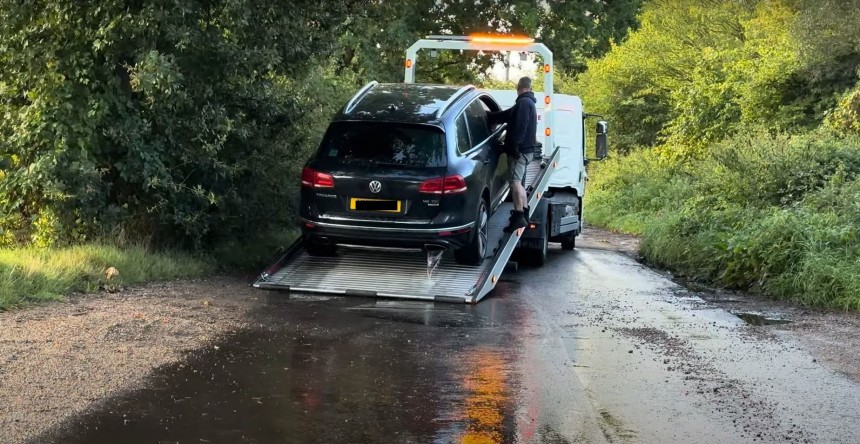The customer is always right because the customer is paying. Their wishes are a business' commands. Automakers adapted to what people preferred and filled our world with crossovers and SUVs that offer limited to no off-road practicality. Some gutsy and unsuspecting drivers of such vehicles learned an important lesson while trying to cross a ford. As a bonus, they offer us a free reminder that water cannot be compressed.
If you have a valid driver's license, then you must have at least heard of how important it is to be mindful of water when on the road. A simple puddle can lead to a disaster if you have some speed and drive through it, thinking nothing can happen.
The contact surface between the tire and the road is small, and even the smallest body of water has some sort of surface tension to it. That's why it can sometimes hurt when jumping into a pool and not going feet first. Most liquids at rest "shrink" at the top because the molecules attract each other and form connections that are hard to break instantly.
Some daredevils attempting risky jumps while on vacation or just trying to show off to their peers have lost their lives because they did not account for what water tension can do to their falling bodies. When a big object hits the water at high velocity, the liquid doesn't have time to move away, and it temporarily feels as hard as concrete, if not even harder.
Besides that, our duty as drivers is to know how to adapt our behavior while behind the steering wheel based on the road conditions. If the path forward is too wet, we should slow down. Aquaplaning is another dangerous phenomenon we must be mindful of. Water can "stick" to the tire because of its increased rotational force, leading to traction loss.
Moving the steering wheel will do nothing until the tire can make contact with the asphalt again. The slower we go when it's rainy, the higher the chances we arrive at our destination safely. Less rotational speed means water can disperse, and the rubber ring can do its job.
But while these aspects might require some advanced form of common sense, crossing a ford or a large body of water should inherently bring forward some self-preservation instincts. Sadly, the marketing used to sell high-riding vehicles that are not in any way, shape, or form off-roaders instilled too much confidence in people who don't read the fine print or ask the right questions.
A Mercedes-Benz GLE driver received a quick reminder that you must be mindful of where your air intake is. Otherwise, you could risk hydrolocking your engine. That almost always results in catastrophic failure and expensive fixes. Fortunately, he didn't increase the speed while crossing the ford and managed to escape.
Sadly, another driver of a 2015-2018 Volkswagen Touareg (replaced stateside in 2017 by the more affordable Atlas) wasn't so lucky. They accelerated with haste, and the engine tapped out. It's unclear if the powerplant tried to compress water and destroyed itself. But the SUV couldn't turn on anymore after nearly finishing the crossing.
They had to call a flatbed and move the vehicle that was spitting water out of its exhaust system.
If you ever have to cross a flooded ford, remember to enter delicately and maintain acceleration steady without increasing or decreasing it. That forms a sort of bow wave that allows the vehicle to push forward without much hassle.
Similarly, if you've been driving for quite some time, don't throw the vehicle in the water immediately. Hot components will most likely be damaged and need replacing. For example, brake rotors can warp because metal can't be cooled down quickly and safely. It's also a good idea to know your vehicle's water-fording capabilities. For example, the F-150 Lightning has a 24-inch wading depth.
Finally, if the water depth seems too dangerous to cross, it's better to trust your instincts. Don't risk it like these drivers did.
The contact surface between the tire and the road is small, and even the smallest body of water has some sort of surface tension to it. That's why it can sometimes hurt when jumping into a pool and not going feet first. Most liquids at rest "shrink" at the top because the molecules attract each other and form connections that are hard to break instantly.
Some daredevils attempting risky jumps while on vacation or just trying to show off to their peers have lost their lives because they did not account for what water tension can do to their falling bodies. When a big object hits the water at high velocity, the liquid doesn't have time to move away, and it temporarily feels as hard as concrete, if not even harder.
Besides that, our duty as drivers is to know how to adapt our behavior while behind the steering wheel based on the road conditions. If the path forward is too wet, we should slow down. Aquaplaning is another dangerous phenomenon we must be mindful of. Water can "stick" to the tire because of its increased rotational force, leading to traction loss.
But while these aspects might require some advanced form of common sense, crossing a ford or a large body of water should inherently bring forward some self-preservation instincts. Sadly, the marketing used to sell high-riding vehicles that are not in any way, shape, or form off-roaders instilled too much confidence in people who don't read the fine print or ask the right questions.
A Mercedes-Benz GLE driver received a quick reminder that you must be mindful of where your air intake is. Otherwise, you could risk hydrolocking your engine. That almost always results in catastrophic failure and expensive fixes. Fortunately, he didn't increase the speed while crossing the ford and managed to escape.
Sadly, another driver of a 2015-2018 Volkswagen Touareg (replaced stateside in 2017 by the more affordable Atlas) wasn't so lucky. They accelerated with haste, and the engine tapped out. It's unclear if the powerplant tried to compress water and destroyed itself. But the SUV couldn't turn on anymore after nearly finishing the crossing.
If you ever have to cross a flooded ford, remember to enter delicately and maintain acceleration steady without increasing or decreasing it. That forms a sort of bow wave that allows the vehicle to push forward without much hassle.
Similarly, if you've been driving for quite some time, don't throw the vehicle in the water immediately. Hot components will most likely be damaged and need replacing. For example, brake rotors can warp because metal can't be cooled down quickly and safely. It's also a good idea to know your vehicle's water-fording capabilities. For example, the F-150 Lightning has a 24-inch wading depth.
Finally, if the water depth seems too dangerous to cross, it's better to trust your instincts. Don't risk it like these drivers did.

















